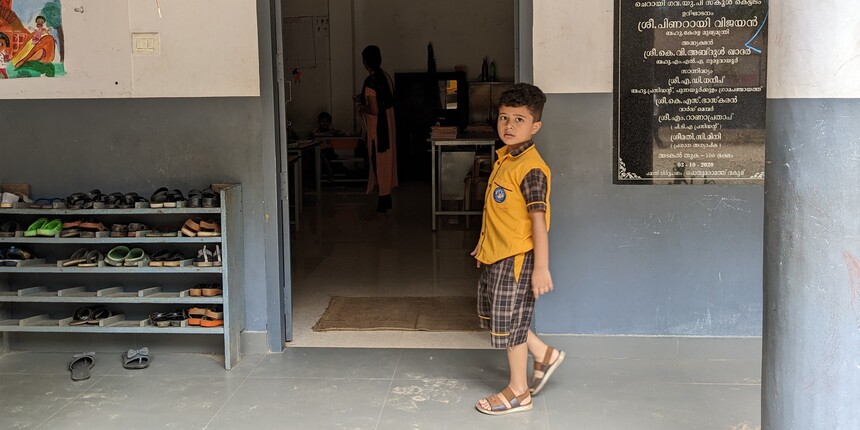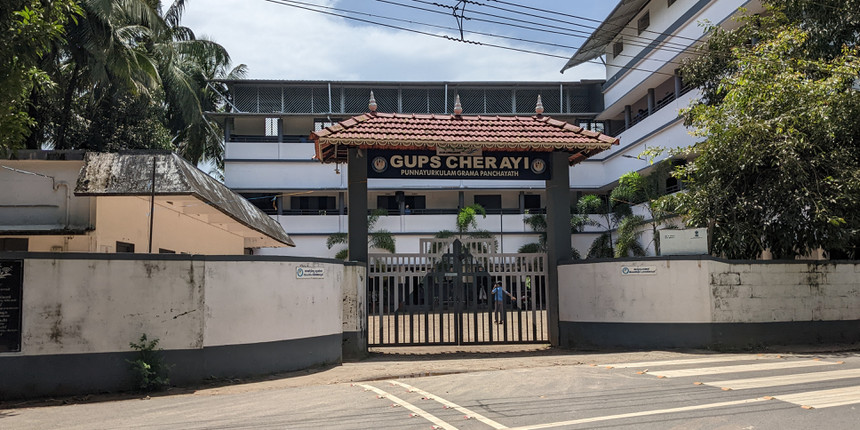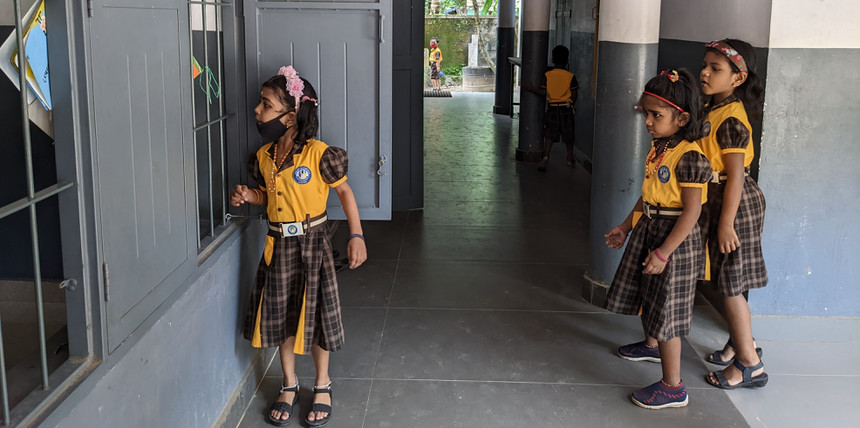How a Kerala village saved its 98 year-old government school and transformed it
Atul Krishna | September 30, 2022 | 01:44 PM IST | 8 mins read
Right to Education: This Kerala government school was set for closure due to low enrolment. Now it has seats ‘booked’ for 2023 admissions.

PUNNAYURKULAM (THRISSUR): In 2016, the Government Upper Primary School Cherayi, on the border between Thrissur and Malappuram districts of Kerala, was sanctioned Rs 10 lakh for a school bus. Immediately after, the Kerala government banned all vehicles except those with Bharat Stage Emission Norms (BS) 4 certificates. BS4 buses cost at least Rs 12 lakh.
Unwilling to wait, the school’s parent-teacher association (PTA) got into action, calling Mahindra showrooms far and wide, until they found a BS4 vehicle available for Rs 10 lakh in Hosur, Tamil Nadu. Surmounting the language barrier, they convinced the Hosur executives to deliver the bus 374 km away to Palakkad. From there, the PTA fetched it, driving it the last 100 km to the school in Punnayurkulam.
That’s the sort of tenacity and dedication that transformed GUPS Cherayi from being one of the most financially unviable government assets that was earmarked for closure, to a school with over 500 students that can barely fit more. Approaching its centenary year, it already has some pre-primary admissions “booked” for the next year and can accommodate new students only in kindergarten.
GUPS Cherayi is an example of what can be achieved by a small school when the surrounding community takes charge of it. Over the past decade, the residents of Cherayi lobbied with local authorities for funds; chipped in to make up for shortfalls, ensuring projects were completed on time; but, most importantly, sent their own children to the school. This decisive intervention transformed old weary buildings with broken clay tiles into a three-storey modern building with tiled floors,digitised classes with projectors, and lockers for students.
From less than 60 students in 2010, the total number of students jumped to 167 in 2017-18, with 96 boys and 71 girls. By 2022-21, it had 527 students enrolled and, for the first time, had more girls (267) than boys (260).
“I joined the school only in July.…As a government school, we cannot deny admission but we have a limit. We can only take admissions in KG sections. Already 10 people have booked their wards’ admission through phone for 2023-2024. We write them down and give admission on a first-come-first-serve basis,” said Lathika VD, headmistress, GUPS Cherayi.
According to the community, this is likely the first government school in the district to have admission pre-booked.
Saved by RTE Act 2009
The first iteration of GUPS Cherayi was a thatched hut set up during British rule, in 1924. It was then part of Malabar district in erstwhile Madras Presidency, which had a literacy rate of just 15 percent. It was one of the nearly 4,000 primary schools in the region, most of them Christian missionary-run private institutions.
It has seen its share of ups and downs. In the 1960s, a hurricane destroyed the hut, killing at least two students. Following the tragedy, the school was moved to rented land. It prospered for a while but then began to suffer due to competition from private players.
“In the ’80s the school had a good name around here. The people and teachers knew each other. But in the 90s, the perception of public schools suffered and parents preferred to send their children to unaided [private] schools,” said Baiju CP, both alumnus and convenor of the pre-primary section at GUPS Cherayi.
 GUPS Cheryai in 2006 when it was close being shut down (source: PTA) The school’s enrollment continued to decline despite some effort from the community to keep it going.
GUPS Cheryai in 2006 when it was close being shut down (source: PTA) The school’s enrollment continued to decline despite some effort from the community to keep it going.
In 1998, the Zilla Panchayat, with some contributions from Cherayi residents, bought 43 cents – 0.43 acres – of land a few hundred metres away from its original location. A four-classroom building came up.
However, with the number of private English-medium schools surging, the poorly-funded, Malayalam-medium government school continued to struggle. By 2006, it was once again dilapidated and there was talk of shutting it down.
“Around 2006-07, there were less than 60 students. As part of a “Focus Programme” the government decided to close unviable government assets and this school was listed as one. Although no direct communication happened with GUPS Cherayi, there was an order saying that schools with few students should be closed since they are a liability,” said Abdul Khader, who was the member of legislative assembly (MLA) from Guruvayur, from 2006 to 2016.
Also Read| Odisha school mergers forcing 10 year-olds to leave home for hostels
This policy of closing down schools is still in practice at the national level. The NEP 2020 talks about ‘merging’ schools into school complexes, which educationists say will effectively close down schools and increase dropouts.
For GUPS Cheryai, the school’s fate hung in the balance for a few years until the Right to Education (RTE) Act 2009 rescued it, mandating a primary school within 1 km of every habitation.
PTA, panchayat take charge
Then, the community stepped in. Cherayi locals understood that for the school to thrive, it has to utilise funds on time.
“A part of the main building was incomplete. The problem was that if the school was to get any more projects or funds, it had to be complete,” said Rana Prathap, involved with the school since 2010, a former PTA president and current chairperson of the School Supporting Group. “I spent money from my own pocket to help finish the project, with the understanding that I will be able to get it back once the school gets the rest of the funds. But I didn’t get the entire amount back.”
Prathap was practically upholding a family tradition. His father was part of the group that funded the purchase of the school land in 1998. He was also inspired by the 2011 Malayalam film, Manikyakallu, about a dedicated professor’s efforts to fix a dysfunctional school.
With pending work complete, the school saw some funds come in. In 2013, it built a pre-primary section. It had close to 150 students in 2014.
 GUPS Cherayi now has digitised classrooms in all sections.
GUPS Cherayi now has digitised classrooms in all sections.
School admission campaign
However, they still struggled to find students for the primary school.
“Even four-five years ago, we had to visit every house to gather students,” said AD Dhaneep, former president of Punnayurkulam Panchayat in which Cherayi is located.
“Even after the pre-primary was added, at one point, we had only three students in Class 1. We had to put UKG students in the Class 1 to show strength,” added Tajjudeen, a PTA executive member.
Also Read| Health plan, toilet ratio, admission guidelines in Kerala’s ‘School Manual’
In the following years, PTA and panchayat members started visiting the community to convince parents to enrol their children in the school. The panchayat led by example. “All of us members enrolled our children in the school. Then, we convinced everyone. If we are enrolling our children, obviously we aim to develop the school,” said Dhaneep.Their efforts resulted in a small uptick in enrolment.
Such campaigns were unusual for government schools, PTA members said. “Only [private] aided-schools did this because they needed to maintain [a certain roll-strength] to continue getting funds. Government school teachers don’t have the responsibility to ensure students,” said Prathap.
PTA as driving force
Local authorities pointed to the PTA as a driving factor behind the school’s development.
“Wherever the PTA is strong, they can collect a lot of funds from the people’s representatives,” said Abdul khader. “Their ability to tackle the difficulties was important. If a file was delayed at the collectorate, they’d go to the collectorate and see the responsible officer to get it passed. This interest was an important factor. The interest from the panchayat was also another important factor. We can say that the MLA, panchayat, parents and teachers all contributed to GUPS Cheryai’s success.”
The PTA’s dedication to getting development projects completed quickly ensured continued flow of funds.
 The latest photo of GUPS Cherayi. “For a school, if some construction is happening, the school authorities are not usually involved. The government will give the work to a public agency and then it is between them and the government. If the agency is the public works department (PWD), then it is between the PWD and the contractor,” said Prathap. “The fact that we [community] have a significant role in all this is often overlooked. The school and village authorities have a voice. We can ask about the materials, quality used.”
The latest photo of GUPS Cherayi. “For a school, if some construction is happening, the school authorities are not usually involved. The government will give the work to a public agency and then it is between them and the government. If the agency is the public works department (PWD), then it is between the PWD and the contractor,” said Prathap. “The fact that we [community] have a significant role in all this is often overlooked. The school and village authorities have a voice. We can ask about the materials, quality used.”
This intense involvement also implies some personal sacrifice. The contractor for one of the latest projects defaulted. Loath to put work on hold, some PTA members contributed a few lakhs toward a paint job. They are hoping to get that money back from the government.
“If we get Rs 1 crore, it’s no good keeping it for five years. If we spend it, we can get another Rs 1 crore. Because results are quick is why Cherayi keeps getting funds. There are schools where Rs 1 crore has been allotted and construction is going on for years,” said Dhaneep.
School funding improves
The school’s financial situation improved drastically after 2016, primarily due to support from the MLA, panchayats and other local authorities.
In 2017, The Kerala Government had announced the Pothuvidyabyasa Samrakshana Yajnam to upgrade 1,000 schools to international standards. GUPS Cherayi was one of them. With the scheme funds, all classrooms were digitised and linked to a common server.
 Students peering into a classroom at the now modernised government school In the subsequent year, the school received Rs 1 crore from the union government’s Rurban Mission. Grants from MLA and MP funds got it a school bus and mini-traveller, to navigate the small pocket roads. In 2020, the school bought another .54 acre land with the help of the panchayat for setting up a playground.
Students peering into a classroom at the now modernised government school In the subsequent year, the school received Rs 1 crore from the union government’s Rurban Mission. Grants from MLA and MP funds got it a school bus and mini-traveller, to navigate the small pocket roads. In 2020, the school bought another .54 acre land with the help of the panchayat for setting up a playground.
“Improved infrastructure played a part in changing perceptions. When the digital classes were introduced it was easier to engage the students especially for science and maths. The school saw its most improvement when we started the pre-primary section in 2013. Prior to that, it was difficult to expect parents to move their children from other schools, “ said Meena Paul, GUPS Cherayi teacher for 18 years.
Authorities attribute the school’s success to some of the same principles that informed the RTE Act 2009. “Even before the Right to Education Act was implemented, Kerala had this concept of a school management committee at the community level. Around 2006, I remember there being extended discussions on this,” said Dhaneep. “A decade ago, there was this concept that the schools belong to the community and if the community neglects it, the school won’t survive. From our experience, we think that concept is why the school has improved so much.”
Follow us for the latest education news on colleges and universities, admission, courses, exams, research, education policies, study abroad and more..
To get in touch, write to us at news@careers360.com.